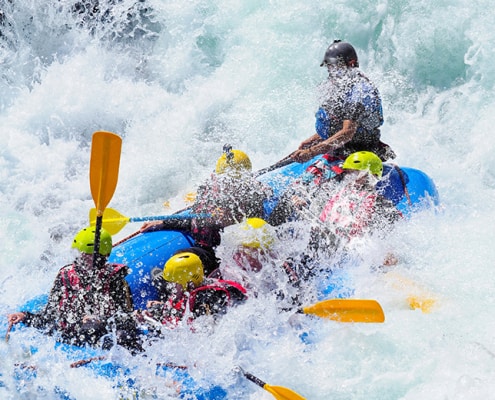Can travel for rafting be considered eco, responsible or sustainable raft tourism? By its very nature, rafting involves travel. In the traditional sense, rafting involves lashing logs together and poling or paddling on water. Human powered transportation of goods or people assisted by water flow from one point to another. Today rafting is more commonly an adventure activity and sport. One which is rarely on the immediate doorstep of anyone going rafting.
Many of the world’s popular rafting destinations are in mountainous climates with limited resources and transport networks. People need to travel to experience rafting. Often this requires long distance travel, usually to a different region or even country. Herein lies the question of sustainable raft tourism.
Here we explore the terms ecotourism, responsible tourism and sustainable tourism as they apply to rafting.
Ecotourism is tourism directed towards exotic, often threatened, natural environments, intended to support conservation efforts and observe wildlife. The United Nations World Tourism Organization (UNWTO) has defined ecotourism as having the following characteristics:
- All nature-based forms of tourism in which the main motivation of the tourists is the observation and appreciation of nature as well as the traditional cultures prevailing in natural areas
- It contains educational and interpretation features
- It is generally, but not exclusively organised by specialised tour operators for small groups. Service provider partners at the destinations tend to be small, locally owned businesses
- It minimises negative impacts upon the natural and socio-cultural environment
- It supports the maintenance of natural areas which are used as ecotourism attractions by:
- Generating economic benefits for host communities, organisations and authorities managing natural areas with conservation purposes;
- Providing alternative employment and income opportunities for local communities;
- Increasing awareness towards the conservation of natural and cultural assets, both among locals and tourists.

As this relates to rafting, many rafting operators around the world have embraced ecotourism. Rafting operators see first hand the impacts of climate change on the natural environment and in particular deforestation, water pollution and water restrictions (hydropower). Sharing news of the devastating impacts and attempting to recoup some of the environmental losses through local projects and wide media engagement.
Operators in locations as varied as Costa Rica, Nepal, India and USA have brought in changes to their operating models whereby multi day trips include local community farming, wild camping, sustainable lodges and leave no trace principles. Each of these ensures that a rafting trip engages the local community, uses local resources rather than imports, reduces footprints in terms of ecological impacts and engages rafting clients in the local community and environment in which they undertake rafting.
Responsible tourism is tourism which minimises negative social, economic and environmental impacts; it generates greater economic benefits and enhances the well-being of local communities. This is where individual rafters can make the difference.
Research raft operators who take responsibility for their impacts on the local communities and environments. Some rafting operators are making great efforts in ensuring they engage local resources, reduce carbon footprints and abide by the ethos of “refuse, reduce, reuse, replace, recycle, remind”. Raft tourists should ask questions. If the rafting operator is unaware of their impacts or is making no efforts to limit their impacts, going rafting with them will only make matters worse. Responsible raft tourism is individual travelers acting to make responsibile choices in their tourism.
Sustainable tourism increases the benefits and reduces the negative impacts caused by tourism for destinations. This can be achieved by protecting natural environments, wildlife and natural resources when developing and managing tourism activities. Sustainable tourism “takes full account of its current and future economic, social and environmental impacts, addressing the needs of visitors, the industry, the environment and host communities” (UNEP & UNWTO, 2005: 11-12. Making Tourism More Sustainable – A Guide for Policy Makers).
The IRF World Rafting Championships 2011 on the Pacuare River (Costa Rica) was the first ever certified carbon neutral world championship level sporting event. Since then more and more sporting and non-sporting events have committed and achieved carbon neutrality. Paris 2024 Olympics have committed to “measure and adapt the carbon footprint every step of the way. Furthermore, Paris 2024 will implement a voluntary compensation plan to offset any unavoidable carbon emissions, even including the impact of spectator travel“. If such a large event can commit to offset such an immense carbon footprint, can smaller rafting operators also commit to sustainable raft tourism?
Sustainable raft tourism is not just the rafting operator working alone. It must involve all touch points of a rafting operation. Sustainability principles refer to the environmental, economic, and socio-cultural aspects of tourism development, and a suitable balance must be established between these three dimensions to guarantee its long-term sustainability (UNWTO). From bookings, transport, catering, on and off water equipment, safety, permits, access, buildings, to all individual people and organisations who are engaged with to make a single raft trip happen.
With so many moving pieces, the key is to reach a balance that embraces tourism but respects the environmental, economic, and societal impacts of tourism. Therefore sustainable raft tourism should:
- Make optimal use of environmental resources, maintain essential ecological processes and help conserve natural heritage and biodiversity
- Respect the authenticity of local communities, conserve their built and living cultural heritage and traditional values, and contribute to inter-cultural understanding and tolerance
- Ensure viable, long-term economic operations, providing socio-economic benefits to all stakeholders that are fairly distributed, including stable employment and income-earning opportunities and social services to host communities, and contributing to poverty alleviation
Sustainable raft tourism should also maintain a high level of tourist satisfaction and ensure a meaningful experience to the tourists, raising their awareness about sustainability issues and promoting sustainable tourism practices amongst them.
Sustainable raft tourism can and does exist
Rafting can be eco, responsible and sustainable tourism. Many rafting operators have found themselves at the brunt of climate change; being witness to devastating impacts brought about through actions not of their own but having to witness and live through the impacts. Observing these impacts, making plans and taking action are key to ensuring that rafting can be sustainable for generations to come.
Although the end goal of sustainable raft tourism seems a lifetime away, starting on the path now will make the journey shorter and easier for everyone in the long run. We’re in this together.
#EcoRafting #ThisIsRafting #TourismStrong #StrongerTogether #SaveTourism #TourismStrong #oneloveoneriver #oneplanet #ClimateAction #Sustainability #RaftersAreAwesome
Are you a rafting operator looking for the first steps in becoming sustainable? Or maybe you’ve taken the first step but need more help? Check out our practical guide to sustainability for rafters for ideas and next steps.



